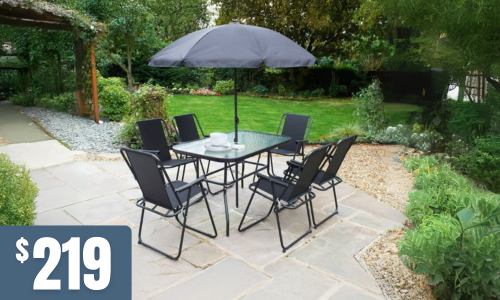Posts tagged with 'defining zones'
-Copy-2.jpg) Furniture isn't just about utility, it sets the stage for how we live and interact in our homes. A well-arranged room fosters conversation, creates a sense of flow, and maximises space. But where do you even begin? Fear not, fellow furniture enthusiasts! This guide will equip you with essential layout ideas for every room in your house.
Furniture isn't just about utility, it sets the stage for how we live and interact in our homes. A well-arranged room fosters conversation, creates a sense of flow, and maximises space. But where do you even begin? Fear not, fellow furniture enthusiasts! This guide will equip you with essential layout ideas for every room in your house.
Living Room: The Hub of the Home
- Conversation Central: Arrange seating areas around a coffee table or fireplace, encouraging face-to-face interaction. Chairs and sofas can be angled slightly towards each other for a more intimate feel.
- Defining Zones: In large living rooms, use furniture to create separate areas. A rug can anchor a seating group, while a bookcase can act as a divider between living and dining areas.
- Entertainment Time: Place the TV and entertainment unit at a comfortable viewing distance, with seating arranged accordingly. Avoid blocking walkways or creating awkward back-to-back layouts.
Dining Room: Meals & Memories
- The Perfect Fit: Ensure your dining table and chairs comfortably fit within the space. Allow enough room to pull out chairs without bumping into walls.
- Shaped for Success: Round or oval tables work well for smaller spaces, promoting conversation flow. Rectangular tables provide ample surface area for larger gatherings.
- Sideboard Savvy: Utilise a sideboard or dresser for additional storage and display. Position it strategically for easy access to crockery and servingware.
Bedroom: Your Personal Sanctuary
- Bedtime Bliss: Position your bed as the focal point, ideally centred on a wall. Leave ample space on either side for bedside tables and easy access.
- Balance & Symmetry: Arrange bedside tables on either side of the bed for visual balance. Consider matching tables for a cohesive look.
- Dress for Success: Place a chest of drawers opposite the bed or along a wall for easy access. Utilise the wall space above the dresser for a mirror or artwork.
Bonus Room Ideas:
- Home Office Powerhouse: Create a dedicated workspace with a desk facing a window for natural light. Position shelves or cabinets within easy reach for essential office supplies.
- Kitchen Efficiency: In a galley kitchen, arrange appliances on opposite walls to create a designated workspace. Utilise a kitchen island or peninsula for additional prep space and seating.
Remember: These are just starting points! Experiment with different layouts to find what works best for your space and lifestyle. Embrace the power of arrangement and transform your home into a haven of functionality and comfort.

Open-plan homes have become increasingly popular in recent years, offering a sense of spaciousness, natural light, and enhanced social interactions. With the absence of walls dividing different living spaces, designing the furniture layout becomes crucial to create a harmonious and functional environment. In this article, we will explore some effective tips and strategies for arranging furniture in open-plan homes to achieve seamless transitions between various areas.
Define Zones
The first step in furniture arrangement for open-plan homes is to define distinct zones within the space. While there may not be physical barriers, you can use furniture and area rugs to visually separate different areas such as the living room, dining area, and kitchen. Each zone should have a specific purpose and flow naturally into the next, ensuring a smooth transition between spaces.
Consider Traffic Flow
One of the key challenges in open-plan homes is managing traffic flow. To maintain a seamless transition, it is essential to keep pathways clear and unobstructed. Avoid placing large furniture pieces in the middle of the room, and position them against walls or the edges of designated zones. This allows people to move freely and creates a sense of openness.
Use Cohesive Design Elements
To create a cohesive and unified look, incorporate design elements that tie the different zones together. Choose a consistent colour palette and style for your furniture, decor, and accessories. This doesn't mean everything has to match perfectly, but having some common elements will help achieve a harmonious overall design.
Consider Sight Lines
In open-plan homes, sight lines play a crucial role in shaping how the space is perceived. Arrange furniture in a way that allows for easy sight lines between different zones. For example, if you are sitting on the sofa in the living area, ensure that you have a clear view of the dining area and kitchen. This fosters a sense of connection between spaces and encourages social interactions.
Scale and Proportion
When choosing furniture for open-plan spaces, pay close attention to scale and proportion. Oversized furniture can overwhelm the room, while too many small pieces can make it feel cluttered. Strive for a balanced mix of furniture sizes that fit well within each zone and complement the overall room size.
Utilise Area Rugs
Area rugs are excellent tools for defining specific zones in open-plan homes. They not only add warmth and texture to the space but also visually separate different areas. Make sure the size of the rug complements the furniture arrangement within each zone, anchoring the pieces together.
Flexibility and Mobility
Open-plan living allows for flexible furniture arrangements, making it easier to adapt the space for various activities and occasions. Consider incorporating furniture with wheels or lightweight pieces that can be easily moved and rearranged to accommodate different needs and gatherings.
Embrace Multifunctional Furniture
In open-plan homes, optimising space is essential. Embrace the concept of multifunctional furniture, such as a dining table that can extend into a workspace or a sofa with hidden storage. These pieces help maximise the usability of the space while maintaining a seamless transition between areas.
Designing furniture arrangements for open-plan homes requires a thoughtful approach to create seamless transitions between different zones. By defining zones, considering traffic flow, using cohesive design elements, and being mindful of sight lines, scale, and proportion, you can achieve a harmonious and functional space that enhances your home's overall appeal. Embrace the versatility of open-plan living, and let your furniture layout reflect your lifestyle and preferences, making it a true reflection of your unique style.
Check out our products!




.jpeg)

 (3).jpeg)
